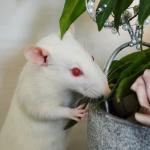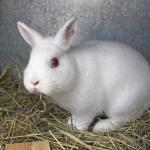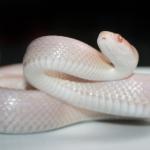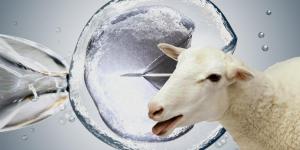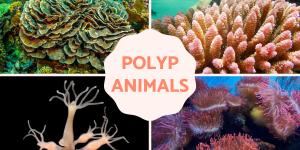What Causes Albino Animals?


The color of an animals skin and coat are one of the many characteristics which allow us to distinguish one species from another. Our fascination with the colors and coat patterns is seen throughout history, in particular with art, design, textiles and many other industries. However, there are some animals within a species which do not conform to the colors and markings of their fellow members. One example of such is albino animals. Albinism, the absence of pigmentation in the skin, can affect many varieties of flora and fauna, including human beings.
AnimalWised answers the question ‘What causes albino animals?’. In doing so, we explain how this curious appearance occurs and how it affects animals which have such pale skin and fur. We also provide you facts about animal albinism, as well as pictures of some of these rare creatures.
What is albinism in animals?
You may have already seen pictures of albino animals. Their striking appearance shows white hair and skin, something which raises much curiosity in us due to its rarity. It is likely you will have met humans with albinism at some point during your life, but seeing albino animals is particularly rare. This is because most of us generally don't live in close enough proximity to see many wild animals.
The cause of albino animals is a scientific one. While there is much folklore and mythology about albinism, we first need to now that it is caused by genetic inheritance. It is caused by the complete or partial absence of melanin in the fur, skin and iris of the animal. Melanin is made up of tyrosine, an amino acid which melanocytes convert to create a particular pigment for a given animal.
The pigmentation created by melanin serves many purposes. It can help camouflage the animal, create patterns to attract mates and even protect against the harmful UV rays which come from the sun. Melanin's usefulness also extends to many interesting aspects of life. Bacteria can use it to protect them from various threats, squid use it to create ink and some moths use it for thermoregulation.
Another term for albinism is hypopigmentation, describing the inability to create melanin for any of the above purposes. While melanin helps in various functions, it is not strictly necessary for survival. Hence why many albino animals still thrive, even if difficulties can arise in the wild. Albinism is hereditary, but it is also recessive. This means that both parents need to carry the albino gene for their offspring to have albinism, even if they are not albino animals themselves.
Animals which have an excess of melanin are called melanistic animals. Their appearance is usually very dark or black, something unlike other animals of their species. This is a form of hyperpigmentation. Albino and melanistic animals are on the opposite sides of the pigmentation spectrum, varying in degrees of color.
Types of albino animals
Albinism occurs at different levels in the animal kingdom. External appearances do not necessarily look the same in all albino animals. Some do not look extremely pale or white, despite carrying the gene. This leads to different types of albino animals which include:
- Ocular albinism: a lack of pigmentation which only occurs in the eyes of the animal.
- Complete albinism (oculocutaneous albinism type 1): this affects the skin, fur and eyes, which show different pale hues, such as white, gray or pink.
- Type 2 oculocutaneous albinism: the individual animal has normal pigmentation in some areas of the body.
- Oculocutaneous albinism types 3 and 4: in these types of albinism, the role of tyrosine is unstable. Albino animals in this category have some normal characteristics, in addition to white spots or areas lacking melanin.
How does albinism affect animals?
We have referenced that albino animals can still manage to thrive in the wild, but their condition does have certain consequences. Physically, albinism results in the following:
- Pink or gray skin: coloration is often due to the visibility of the bloodstream seen through the colorless dermis. It will depend on the thickness of an animal's skin. Albino alligators, for example, appear very white as you cannot see the blood vessels underneath.
- Red or pink eyes: in animals with complete albinism, the color of the eyes will be red or pink.
- Blue, brown or green eyes: in animals with oculocutaneous albinism 2, 3 and 4, the effects are not as strong, leading to paler colors, but not necessarily pink.
- Pale, blond, grayish or white fur: again, the type of albinism will determine the extent of the lack of coloration.
- Sun sensitivity: intolerance or sensitivity to prolonged sun exposure can be very dangerous, especially in countries with hot climates.
- Decreased visual acuity: something which can be particularly dangerous for animals which rely on sight for hunting or evading predation.
- Hearing problems: creates similar problems for animals in the wild as poor vision.
The consequences for wild albino animals go beyond physical appearances or the reduction in acuity of some senses. In nature, an albino animal lacks the camouflage necessary to hide from predators. Not only this, but their light coloration means they stand out from their environment and are easier targets. A direct result is that the life expectancy of wild albino animals is drastically reduced.
Albinism affects many animal species, including both vertebrate and invertebrate animals. It is difficult to say which are the rarest albino animals in the world, since they all are relatively rare. However, it is a much more common trait in domestic animals species such as mice, cats, dogs and rabbits. In the wild, known animals with albinism include gorillas, snakes, turtles, zebras, frogs, caribou, giraffes, crocodiles and many others.
If you have an albino companion animal, you may need some specific care information. We provide this in our articles on characteristics of an albino dog and caring for albino cats.

Famous albino animals
Due to the unique appearance of albino animals and their rarity, there are animals with hypopigmentation which have become famous worldwide. Some of them have already passed away, but their impact is still felt and their uniqueness helps us to learn more about the animal kingdom in general. Here are some of the most famous albino animals in the world:
- Snowdrop: an albino South African penguin. He died in 2004 at a zoo in the United Kingdom, where he had gained true celebrity status.
- Snowflake: an albino gorilla and one of the best known albino animals in the world. There are no records of other albino gorillas. He lived in the zoo of Barcelona until 2003, dying of skin cancer likely related to his condition at an estimated 40 years of age.
- Claude: is an albino crocodile that lives in California, in the swamp that is housed inside the grounds of the Academy of Sciences.
- Pearl: another female albino crocodile, this time sighted in Australia.
- Onya: a rare case of albinism in koalas, currently living in Australia.
- Migaloo: since 1991 there have been sightings of this albino humpback whale that frequents the Australian coast.
Below is a picture of snowflake taken at the Barcelona Zoo:
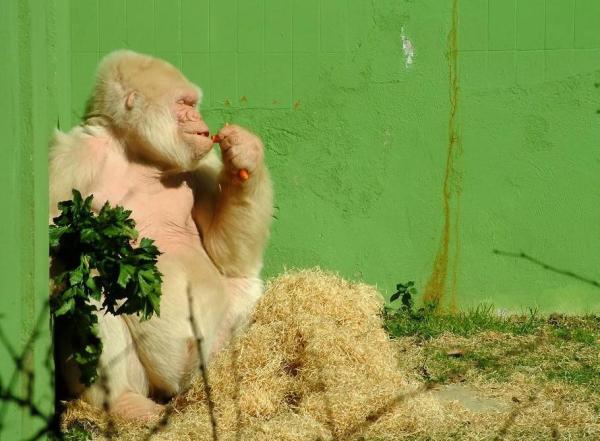
Albino animals and their conservation
Many animal species are in danger of extinction today. This affects both normal individuals and those which have been affected by albinism. There are currently no records of the endangerment of albino animals due to their rarity. The specific genetic conditions which lead to albinism occurring in the wild are very difficult to replicate. Tracing the genetic history of wild animals can be an impossible task.
There have been some attempts to breed albino animals in captivity. However, as was the case with Snowflake the gorilla, attempts to engineer albino animals have been largely unsuccessful[1]. Snowflake had 22 offspring in total, with 6 surviving into adulthood. None of them were albino.
Unfortunately, due to the perverse nature of hunters and poachers, rarity is a prize many search for. This means albino animals are not only easy targets for animal predators, but are actively sought out by humans. White lions are not actually albinos, but they are rarer than other lions. They are, therefore, often highly prized by big game hunters. This doesn't necessarily mean they are in more danger than others.
If you want to read similar articles to What Causes Albino Animals?, we recommend you visit our Facts about the animal kingdom category.
1. Taylor, D. (1991). Vet on the Wild Side: Further Adventures of a Wildlife Vet. London: St. Martin's Press.
https://www.amazon.com/Vet-Wild-Side-Adventures-Wildlife/dp/0312055293
- Martínez-Coronel, M., Bautista, R., & Verona-Trejo, M. I. (2013). Plabinist albinism in Liomys pictus (Mammalia: Heteromyidae). Therya, 4 (3), 641-645.
https://www.researchgate.net/publication/275497109_Albinismo_platinado_en_Liomys_pictus_Mammalia_Heteromyidae - De Alba, J. (1964). Reproduction and animal genetics. Costa Rica: Inter-American Institute of Agricultural Sciences of the OAS.
- Kamaraj, B., & Purohit, R. (2014). Mutational analysis of oculocutaneous albinism: a compact review . BioMed Research International, 905472.
https://www.ncbi.nlm.nih.gov/pubmed/25093188
What Causes Albino Animals? photos


